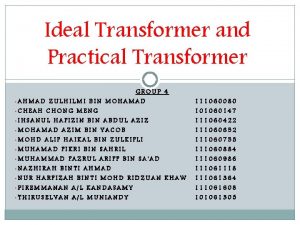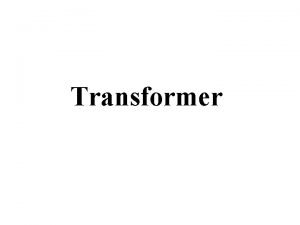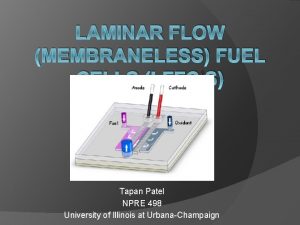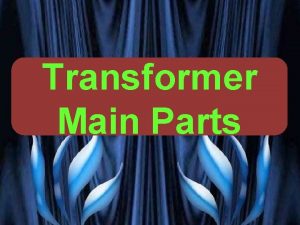Cooling of Transformer VG PATEL TRANSFORMER ENCYCLOPAEDIA Cooling


















- Slides: 18

Cooling of Transformer VG PATEL

TRANSFORMER ENCYCLOPAEDIA Cooling of Transformer Cooling system is required for transformer to take away the heat generated in transformer due to losses and maintaining insulation healthy. Cooling system of transformer is provided by considering design and KVA rating of a transformer. Cooling system of transformer is as follows; Wednesday, January 5, 2022 VG PATEL 2

TRANSFORMER ENCYCLOPAEDIA Cooling of Transformer i. Air natural cooling system. ii. Oil natural cooling system with or without radiator. iii. Cooling of transformer improved by force airflow by blowers/Air blast by fans. iv. Oil forced natural cooling system (OFN): - circulation of oil by pump to radiator, which has natural cooling. v. OFB: Forced oil circulation of oil by pump to radiator, which has force, cooled by air blower. vi. OFW: Forced circulation of Oil through oil cooler and water-cooling is by water. Generally Oil temp is maintained in between 45 to 550 C. & Winding temp in between 55 to 800 C. (depends upon insulation class). Wednesday, January 5, 2022 VG PATEL 3

TRANSFORMER ENCYCLOPAEDIA Cooling of Transformers are valuable assets in power systems. It appears worthwhile to pay special attention to this key component to ensure stability in power systems. Cellulose insulation is used in most power transformers until yet. The ageing rate of the paper-oil insulation in transformers strongly depends on the temperature. There is a strong interest to determine the winding hottest spot temperature which is also the limiting factor for transformer loading. This temperature can be determined by the load conditions, the winding design and the ambient oil temperature given by the cooling equipment. The heat transfer phenomena inside transformer windings are complex and presently there is no universal thermal winding model available. Changing boundary conditions and manufacturing tolerances influence analytic and numeric heat transfer calculations strongly. Many winding types, each with different cooling duct designs, are in use to meet customer requirements and to reach competitive design solutions. Wednesday, January 5, 2022 VG PATEL 4

TRANSFORMER ENCYCLOPAEDIA Cooling of Transformer Thermal aspects affect transformer design. Therefore precise temperature calculations ensure good quality and long life expect-ancy of transformers. The temperature gradient between conductor and oil consists of a gradient inside the solid winding insulation and a gradient inside the boundary layer at the winding surface. The gradient inside the solid insulation depends on the thickness of the enamel, paper insulation and oil pockets between conductor and paper wrapping. The heat transfer at the winding surface is determined by the cooling conditions. Another important thermal design aspect is the longitudinal temperature gradient inside ON-cooled windings. This value results from a balance of the natural convective oil driving forces accelerating the oil flow and hydraulic resistances in the oil circuit slowing down the oil flow. Further hydraulic resistances outside the winding are able to reduce the oil flow through ON-cooled windings additionally. Wednesday, January 5, 2022 VG PATEL 5

TRANSFORMER ENCYCLOPAEDIA Cooling of Transformer • The insulating materials have limited thermal withstand capacity. Hence, their temperature needs to be restricted. • Effect of high altitude – Reduction in air density – i. e. reduced No. of air molecules per unit volume • At 1000 m above MSL, this effect is predominant • Standards suggest reduction in temperature rise limits. Wednesday, January 5, 2022 VG PATEL 6

TRANSFORMER ENCYCLOPAEDIA Cooling of Transformer COOLING CLASS Wednesday, January 5, 2022 VG PATEL 7

TRANSFORMER ENCYCLOPAEDIA Cooling of Transformer Wednesday, January 5, 2022 VG PATEL 8

TRANSFORMER ENCYCLOPAEDIA Cooling of Transformer Cooling Class Letter Description Internal First Letter (Cooling Medium) Second Letter (Cooling Mechanism) Code Letter Description O K Liquid with flash point less than or equal to 3000 C Liquid with flash point greater than 3000 C L Liquid with no measurable flash point N A W Natural convection through cooling equipment and windings Forced circulation through cooling equipment, natural convection in windings Forced circulation through cooling equipment, directed flow in main windings Air Water N F Natural convection Forced circulation F D External Third letter (Cooling medium) Fourth letter (Cooling Mechanism) Wednesday, January 5, 2022 VG PATEL 9

TRANSFORMER ENCYCLOPAEDIA Cooling of Transformer VARIOUS TYPES OF COOLING 1) Air Natural (AN) 2) Air Blast (AB) 3) Oil Natural (ON) or Oil Natural Air Natural (ONAN) 4) Oil Natural Air Forced (ONAF) 5) Oil Forced Air Natural (OFAN) 6) Oil Forced Air Forced (OFAF) 7) Oil Natural Water Forced (ONWF) Wednesday, January 5, 2022 VG PATEL 10

TRANSFORMER ENCYCLOPAEDIA Cooling of Transformer According to cooling A) Air Cooling For Dry Type Transformers: It is used for transformers that use voltages below 25 KV 1) Air natural Type (A. N. ) • This type of Transformer Cooling method applies to dry type transformer of small rating. • As power ratings increase, transformers are often cooled by forced-air cooling 2) Air Forced type (A. F. ) • The air is forced on to the tank surface to increase the rate of heat dissipation. • The fans are switched on when the temperature of the winding increases above permissible level. Wednesday, January 5, 2022 VG PATEL 11

TRANSFORMER ENCYCLOPAEDIA Cooling of Transformer B) Cooling For Oil Immersed Transformers: 1) Oil Natural Air Natural Type (O. N. A. N. ) • This type of Transformer cooling is widely used for oil filled transformers up to about 30 MVA. • Heat is transferred from transformer windings and core to the oil and the heated oil is cooled by the natural air. • Cooling area is increased by providing the cooling tubes. This is the simplest transformer cooling system. Here, natural convectional flow of hot oil is utilized for cooling. In convectional circulation of oil, the hot oil flows to the upper portion of the transformer tank and the vacant place is occupied by cold oil. This hot oil which comes to upper side, will dissipate heat in the atmosphere by natural conduction, convection & radiation in air and will become cold. In this way the oil in the transformer tank continually circulate when the transformer put into load. As the rate of dissipation of heat in air depends upon dissipating surface of the oil tank, it is essential to increase the effective surface area of the tank. So additional dissipating surface in the form of tubes or radiators connected to the transformer tank. Wednesday, January 5, 2022 VG PATEL 12

TRANSFORMER ENCYCLOPAEDIA Cooling of Transformer B) Cooling For Oil Immersed Transformers: 2) Oil Natural Air Forced Type (O. N. A. F. ) • In higher rating transformers where the heat dissipation is difficult, this type of cooling is used. • Fans are used to forced and air blast on radiators. Heat dissipation can obviously be increased, if dissipating surface is increased, but it can be made further faster by applying forced air flow on that dissipating surface. Fans blowing air on cooling surface is employed. Forced air takes away the heat from the surface of radiator and provides better cooling than natural air. As the heat dissipation rate is faster and more in ONAF transformer cooling method than ONAN cooling system, electrical power transformer can be put into more load without crossing the permissible temperature limits. Wednesday, January 5, 2022 VG PATEL 13

TRANSFORMER ENCYCLOPAEDIA Cooling of Transformer 3) Oil Forced Air Forced Type (O. F. A. F. ) • Oil Natural Air Forced type of cooling is not adequate to remove the heat caused by the losses. • Transformers above 60 MVA employ a combination of Forced Oil and Forced Air Cooling. In oil forced air natural cooling system of transformer, the heat dissipation is accelerated by using forced air on the dissipating surface but circulation of the hot oil in transformer tank is natural convectional flow. The heat dissipation rate can be still increased further if this oil circulation is accelerated by applying some force. In OFAF cooling system the oil is forced to circulate within the closed loop of transformer tank by means of oil pumps. The main advantage of this system is that it is compact system and for same cooling capacity OFAF occupies much less space than farmer two systems of transformer cooling. Actually in oil natural cooling system, the heat comes out from conducting part of the transformer is displaced from its position, in slower rate due to convectional flow of oil but in forced oil cooling system the heat is displaced from its origin as soon as it comes out in the oil, hence rate of cooling becomes faster. Wednesday, January 5, 2022 14 VG PATEL

TRANSFORMER ENCYCLOPAEDIA Cooling of Transformer 4) Oil Forced Water Forced (O. F. W. F. ) • This type of cooling Is provided for very large transformers which have ratings of some hundreds of MVA. • This type of transformers is used in large substations and power plants. We know that ambient temperature of water is much less than the atmospheric air in same weather condition. So water may be used as better heat exchanger media than air. In OFWF cooling system of transformer, the hot oil is sent to oil to water heat exchanger by means of oil pump and there the oil is cooled by applying showers of cold water on the heat exchanger's oil pipes. Wednesday, January 5, 2022 VG PATEL 15

TRANSFORMER ENCYCLOPAEDIA Cooling of Transformer 5) Oil Directed Air Forced (O. D. A. F. ) ODAF or cooling of transformer can be considered as the improved version of OFAF. Here forced circulation of oil directed to flow through predetermined paths in transformer winding. The cool oil entering the transformer tank from cooler or radiator is passed through the winding where gaps for oil flow or pre-decided oil flowing paths between insulated conductor are provided for ensuring faster rate of heat transfer. ODAF or oil directed air forced cooling of transformer is generally used in very high rating transformer. 6) Oil Directed Water Forced (O. D. W. F. ) ODWF or oil directed water forced cooling of transformer is just like ODAF only difference is that here the hot oil is cooled in cooler by means of forced water instead of air. Both of these transformer cooling methods are called forced directed oil cooling of transformer. Wednesday, January 5, 2022 VG PATEL 16

TRANSFORMER ENCYCLOPAEDIA OPEN FORUM Wednesday, January 5, 2022 17

TRANSFORMER ENCYCLOPAEDIA THANQ Wednesday, January 5, 2022 18
 What is ideal and practical transformer
What is ideal and practical transformer Transformer is static device
Transformer is static device Dr nisha patel
Dr nisha patel Rs patel
Rs patel A. d. patel
A. d. patel Dr amruta patel
Dr amruta patel Guide planes in rpd
Guide planes in rpd Patent valuation methodology
Patent valuation methodology Kanika kitchlu-connolly
Kanika kitchlu-connolly Dr ebrahim patel
Dr ebrahim patel Anisha patel md
Anisha patel md David siddhartha patel
David siddhartha patel Dr tapan patel wikipedia
Dr tapan patel wikipedia Ash patel md
Ash patel md Amirah shaikh
Amirah shaikh Trypanosoma brucie
Trypanosoma brucie Krunal patel md
Krunal patel md Dr nidhi patel
Dr nidhi patel Dr niraj patel
Dr niraj patel



































